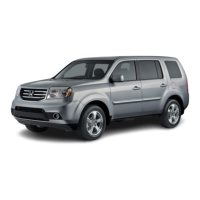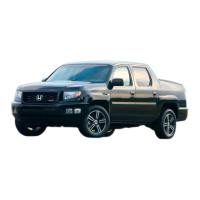
Do you have a question about the Honda CRV 2012 and is the answer not in the manual?
| Brand | Honda |
|---|---|
| Model | CRV 2012 |
| Category | Automobile |
| Language | English |
Explains vehicle safety features and provides precautions.
Essential safety guidelines for driving, including seat belts and child safety.
Information on vehicle handling, especially regarding rollover risk and off-highway driving.
Overview of safety features like safety cage, crush zones, and airbags.
Information on seat belt usage, types, and maintenance for occupant protection.
Details on airbag system components, types, and operation for crash protection.
Guidelines for properly restraining infants and children in the vehicle for their safety.
Warning about carbon monoxide gas emitted from the engine exhaust.
Information on the location and meaning of safety warning labels on the vehicle.
Explanation of various warning lights and indicators on the instrument panel.
Description of speedometer, tachometer, fuel, and temperature gauges.
Details on the odometer, trip meter, and fuel economy displays.
Information on displaying audio status, compass direction, and clock.
Instructions for adjusting the vehicle's clock display.
Procedures for locking/unlocking doors using keys, remote, or interior switches.
Guidelines for safely opening and closing the vehicle's tailgate.
Information on the immobilizer system and security alarm functions.
How to operate power windows, including auto and manual modes.
Instructions for operating the moonroof in automatic, manual, and tilt modes.
Guide to using controls like ignition switch, turn signals, and lights.
How to adjust interior rearview and power door mirrors for optimal visibility.
Procedures for adjusting front manual and power seats, including posture and headrests.
Information on interior lighting controls and convenience features like glove box and cup holders.
Guide to using vents, heating, and air conditioning controls.
Instructions for operating the automatic climate control system.
Overview of the vehicle's audio system capabilities, including radio, CD, USB, and Bluetooth.
Instructions for using steering wheel controls to operate the audio system.
How to use the Bluetooth system for phone calls and audio streaming.
Information on the vehicle's compass system and calibration.
Essential checks and preparations before starting to drive the vehicle.
Guidelines and precautions for safely towing a trailer with the vehicle.
Tips and precautions for driving on unpaved roads and handling off-road situations.
Information on starting the engine, driving precautions, and shift lever operation.
Explanation of automatic transmission operation, including creeping and kickdown.
Guide to changing shift positions and operating the shift lever.
How the ECON button helps improve fuel economy by adjusting vehicle systems.
Instructions on how to use cruise control for maintaining a constant vehicle speed.
How the VSA system helps stabilize the vehicle during cornering and maintains traction.
Explanation of how the AWD system transfers power to rear wheels for better traction.
How the TPMS monitors tire pressure and indicates under-inflation.
Federal explanation regarding TPMS operation and maintenance.
Information on the vehicle's brake system, including parking brake and foot brake.
Steps and precautions for safely parking the vehicle.
How to use the multi-view rear camera for better visibility when backing up.
Information on fuel recommendations, tank capacity, and how to refuel the vehicle.
Details on recommended fuel types and additives for optimal engine performance.
Step-by-step guide on how to safely refuel the vehicle.
Tips for improving fuel economy through maintenance and driving habits.
Guidelines for installing accessories and precautions regarding vehicle modifications.
General guidelines and safety precautions before performing maintenance tasks.
List of daily and periodic inspections required to keep the vehicle in good condition.
Recommendation for using Honda genuine parts and fluids for vehicle maintenance.
Explanation of the Maintenance Minder system for tracking service needs.
Overview of maintenance items located under the hood of the vehicle.
Information on checking and refilling engine coolant, including specifications and warnings.
Guide to checking and adding automatic transmission fluid, with specifications and cautions.
Instructions on checking brake fluid level and type, with warnings about incompatible fluids.
How to refill the windshield washer fluid reservoir and precautions.
Step-by-step instructions for replacing various exterior and interior light bulbs.
How to check, clean, and replace front and rear wiper blades for optimal performance.
Guidelines for checking tire pressure, tread wear, and condition.
Explanation of the tire and loading information label found on the driver's doorjamb.
How to read tire markings, including size, load rating, and speed rating.
How to identify worn tires using tread wear indicators to ensure proper traction.
Factors affecting tire lifespan and recommendations for inspection and replacement.
Guidelines for selecting and using winter tires and tire chains for safe driving in cold conditions.
Information on checking battery condition, terminals, and precautions for charging.
How to replace the button battery in the remote transmitter.
Care instructions for remote controls and wireless headphones, including battery replacement.
Maintenance procedures for the dust and pollen filter in the climate control system.
Guidelines for cleaning the vehicle's interior surfaces and seat belts.
Tips for cleaning interior components, including warnings about liquids and sprays.
Procedures for washing, waxing, and cleaning exterior surfaces and wheels.
List of tools stored in the cargo area for vehicle maintenance and emergencies.
Step-by-step instructions for changing a flat tire using the vehicle's tools.
Troubleshooting steps for when the engine fails to start, including checks for battery and fuses.
Procedure for releasing the shift lever lock if it cannot be moved from Park.
How to handle engine overheating, including immediate actions and next steps.
Explanation of various indicator lights and what to do when they appear.
Information on fuse locations and how to inspect and change fuses.
Guidelines for contacting professional towing services when needed.
Procedure for opening the tailgate manually if it cannot be opened normally.
Detailed specifications of the vehicle, including dimensions, weights, and fluid types.
Locations of the Vehicle Identification Number (VIN) and engine/transmission numbers.
Information on vehicle systems that emit radio waves and FCC compliance.
Procedures for reporting safety defects to NHTSA (US) or Transport Canada.
Explanation of readiness codes and procedures for preparing the vehicle for emissions testing.
Overview of new vehicle, emissions, seat belt, rust, accessory, and replacement parts warranties.
Information on how to obtain service publications and owner's manuals.
Contact information for Honda customer service and required details for inquiries.












